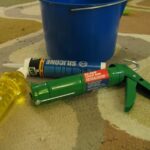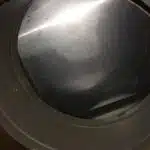As a bathroom cleaning expert, I have encountered many different types of dirt and grime throughout my career. However, one of the most stubborn and frustrating substances to clean is soap scum. Soap scum can accumulate on every surface in your bathroom, from the shower walls to the sink basin. It is an unsightly and unhygienic problem that needs to be addressed regularly to maintain a clean and healthy environment.
In this article, we will explore how to effectively clean soap scum off of every bathroom surface using simple household items and professional cleaning techniques. We will cover everything from identifying soap scum buildup to selecting the best cleaning products for each surface. By following these tips and tricks, you can say goodbye to stubborn soap scum and hello to a sparkling clean bathroom. So let’s get started!
Understanding Soap Scum Buildup
The bathroom is one of the most used rooms in a household, and it is essential to keep it clean and hygienic at all times. One of the biggest challenges in keeping a bathroom clean is dealing with soap scum buildup. Soap scum occurs when soap mixes with water and mineral deposits, creating a white or grey film on surfaces.
Causes of soap scum include using hard water, not rinsing off soap properly, and using bar soap instead of liquid soap. Hard water contains minerals that react with the soap to form scum, while bar soaps have added fats that can stick to surfaces. Additionally, failing to rinse off soap after washing can leave behind residue that will eventually lead to buildup.
Preventing soap scum starts with proper cleaning techniques. Wiping down surfaces after each use prevents water from drying up and leaving behind minerals that cause buildup. Additionally, using liquid soaps instead of bar soaps reduces the amount of residue left behind. Lastly, regular cleaning with appropriate solutions keeps surfaces free from buildup and helps maintain their shine.
Understanding the causes of soap scum and taking preventative measures can go a long way in ensuring your bathroom remains clean and hygienic. However, if you already have buildup on your surfaces, it’s important to identify them correctly before attempting any cleaning methods.
Identifying Soap Scum On Different Surfaces
Soap scum is a common problem in every bathroom. It can be identified as a thin layer of white or grayish film that sticks to the surfaces of your shower, bathtub, sink, and even toilet bowl. The buildup of soap scum occurs due to the combination of hard water minerals, body oils, and soap residue that are left behind after bathing or washing your hands.
There are different types of surfaces in your bathroom where you may find soap scum buildup. Each surface requires different cleaning techniques and products. For example, if you have a fiberglass or acrylic shower stall, you need to be careful not to use abrasive cleaners that can scratch the surface. On the other hand, if you have a porcelain bathtub or sink, you can use more aggressive cleaning agents without worrying about scratching the surface.
To prevent soap scum buildup from happening in your bathroom, there are several things you can do. First, try using liquid body wash instead of bar soap since it tends to leave less residue. Second, wipe down your shower walls with a squeegee after each use to remove excess water and prevent mineral deposits from building up on the surface. Finally, consider installing a water softener system in your home to reduce the amount of hard water minerals that come into contact with your bathroom surfaces.
Three Ways To Prevent Soap Scum Buildup:
- Use liquid body wash instead of bar soap.
- Wipe down shower walls with a squeegee after each use.
- Consider installing a water softener system in your home.
In summary, identifying soap scum buildup on different surfaces in your bathroom is crucial for effective cleaning. Knowing what causes soap scum and how to prevent its buildup can save time and effort when it comes time to clean. By implementing preventative measures such as using liquid body wash and wiping down shower walls after each use, you can keep your bathroom surfaces looking clean and shiny for longer.
Gathering Materials And Tools For Cleaning
When it comes to cleaning soap scum off of bathroom surfaces, having the right materials and tools is crucial. Before diving into the cleaning process, it’s important to gather everything you need to ensure a successful outcome. The best products for removing soap scum vary depending on the surface you’re cleaning, so it’s important to choose the right one for each area.
For shower doors and tiles, a commercial soap scum remover can be effective. Look for one that contains citric acid or vinegar, which help break down the buildup. For porcelain or ceramic sinks and tubs, a baking soda paste can be used to scrub away soap scum without damaging the surface. And for chrome fixtures and faucets, rubbing alcohol or white vinegar can be used to remove buildup while shining up the metal.
When it comes to cleaning techniques, using a soft-bristled brush or sponge can help prevent scratches on delicate surfaces like glass or porcelain. It’s also important not to let the soap scum sit for too long before cleaning it off, as this can make it harder to remove. With the right products and techniques in hand, you’ll be ready to tackle even the toughest soap scum buildup in your bathroom.
Transition: Now that you have all of your materials and tools ready for cleaning, it’s important to keep safety in mind as well. In order to prevent any accidents or injuries during your cleaning process, there are some key safety tips that you should follow.
Preparing For Cleaning: Safety Tips
- Preparation is key when tackling a bathroom cleaning project: gathering the necessary supplies, protecting the skin, and ensuring proper ventilation are essential.
- Gather supplies such as cleaning gloves, sponges, and a mild soap scum remover to ensure the job is done as safely and efficiently as possible.
- When using any cleaning products, it is important to wear protective gloves and clothing to protect the skin from any harsh chemicals.
- Lastly, make sure the room is properly ventilated to allow the cleaning products to disperse away from the user and to prevent any harm from breathing in any fumes.
Gather Supplies
When preparing to clean your bathroom, it is important to gather all the necessary supplies to ensure that you can clean every surface effectively and efficiently. One of the first steps in organizing supplies for cleaning is to sort through what you already have. Check under your sink, in any closets or cabinets, and even in your garage for any cleaning tools or products that you may have forgotten about. This will not only help you save money by using what you already have, but also prevent unnecessary waste.
Budget-friendly options for cleaning supplies include vinegar, baking soda, and dish soap. These household items can be used on a variety of surfaces such as tile, glass, and porcelain without causing any damage. They are also effective at removing soap scum buildup while being gentle enough not to scratch or harm any surfaces. Additionally, reusable microfiber cloths are an eco-friendly alternative to disposable paper towels.
Lastly, when gathering supplies for cleaning your bathroom it is important to consider safety precautions. Make sure you wear gloves and protective eyewear when using harsh chemicals like bleach or ammonia. Also be sure to properly ventilate your bathroom by opening windows or turning on fans before beginning your cleaning routine. By taking these simple steps when gathering supplies for cleaning your bathroom, you can ensure a safe and successful cleaning experience.
Protect Skin
When preparing to clean your bathroom, safety is of utmost importance. Protective gear should be a top priority when considering what supplies you need. Gloves and eyewear are essential when using harsh chemicals like bleach or ammonia. This will help prevent skin irritation and injury.
In addition to protective gear, it is also important to consider natural remedies for cleaning. Many cleaning products contain harmful chemicals that can cause skin irritation or allergic reactions. Using natural remedies such as vinegar, baking soda, and dish soap can be just as effective without the risk of harm. These alternatives are also more eco-friendly than traditional cleaning products.
To further protect your skin during the cleaning process, be sure to rinse off any cleaning solutions thoroughly after use. Leaving residue on your skin can cause irritation and dryness. Also, consider using moisturizer after cleaning to keep your skin hydrated and healthy. By taking these simple steps, you can ensure that you are protecting your skin while keeping your bathroom clean and safe for use.
Cleaning Soap Scum From Shower Walls And Tiles
After taking the necessary safety precautions, it’s time to tackle the task of cleaning soap scum from shower walls and tiles. Soap scum is a common problem in bathrooms that can be difficult to remove, but with the right tools and techniques, it can be done effectively.
Firstly, preventing buildup is key to minimizing soap scum. Use a squeegee or towel after each shower to remove excess water from surfaces. Also, switch to liquid soap instead of bar soap as it tends to leave less residue. Secondly, when removing stains, avoid using abrasive materials such as steel wool or scrub brushes as they can scratch surfaces. Instead, use a non-abrasive cleaner and let it sit for a few minutes before wiping down with a soft cloth or sponge.
Lastly, maintaining cleanliness is important in preventing future buildup. Regularly clean surfaces with a mild detergent and water solution or vinegar and water mixture. Additionally, ensure proper ventilation in the bathroom by opening windows or running an exhaust fan during and after showers.
By following these tips for preventing buildup and removing stains, you’ll be able to effectively combat soap scum on your shower walls and tiles.
Markdown bullet point list:
- Use a squeegee or towel after each shower
- Switch to liquid soap instead of bar soap
- Avoid using abrasive materials
- Regularly clean surfaces with mild detergent or vinegar solution
Transition sentence: “Now that we’ve covered cleaning soap scum from shower walls and tiles, let’s move on to cleaning soap scum from glass shower doors.”
Cleaning Soap Scum From Glass Shower Doors
- Removing soap scum from glass shower doors can be a time consuming task, but it is possible with the right cleaning products and techniques.
- Cleaning products such as a vinegar and water solution, or products containing solvents and surfactants can help break down the soap scum and make removal easier.
- Professional grade cleaners containing hydrochloric acid, sodium hypochlorite, and ammonia can be effective at removing soap scum, but should be used with caution to avoid damaging the surface.
- A soft cloth or scrubbing pad can be used to help remove soap scum, but it is important to use a gentle motion to avoid damaging the surface of the glass.
- Once the soap scum has been removed, it is important to rinse the surface with clean water to remove any remaining cleaning products.
- To prevent re-accumulation of soap scum, it is important to regularly clean the surface with a mild cleaning product and rinse with water.
Removing Soap Scum
Removing soap scum from glass shower doors can be a frustrating task for homeowners. Soap scum is a buildup of soap residue mixed with hard water minerals, which can cause the glass to become cloudy and dull over time. It is important to understand the causes of soap scum in order to effectively prevent its buildup on shower doors.
One of the main causes of soap scum is using hard water while showering. Hard water contains high levels of calcium and other minerals, which react with soap to form a film that sticks to surfaces. To prevent soap scum buildup, consider installing a water softener or using a vinegar rinse after each shower. Additionally, regularly cleaning your shower doors with an effective cleaner can help reduce the amount of soap scum that accumulates.
When it comes to removing soap scum from glass shower doors, there are several effective methods. One popular method involves using a mixture of baking soda and vinegar to create a paste that can be applied directly onto the glass surface. Another option is using commercial cleaners specifically designed for removing soap scum. Whichever method you choose, it is important to wear gloves and thoroughly rinse the surface after cleaning.
In conclusion, preventing and removing soap scum from glass shower doors requires consistent effort and care. By understanding the causes of soap scum and implementing prevention methods such as using soft water and regular cleaning, homeowners can keep their bathroom surfaces looking clean and clear. When it comes time for deep cleaning, there are several effective methods available that can leave your glass shower doors sparkling like new.
Cleaning Products
When it comes to cleaning soap scum from glass shower doors, choosing the right cleaning product is crucial. There are many soap scum removal techniques available, but not all of them are equally effective. It is important to select a cleaning product that can effectively break down the buildup of soap scum without damaging the glass surface.
One popular option for cleaning soap scum from glass shower doors is using commercial cleaners specifically designed for this purpose. These products often contain powerful chemicals that can quickly dissolve soap scum and mineral buildup. However, some people may be concerned about the potential health and environmental risks associated with these harsh chemicals.
For those looking for eco-friendly cleaning options, there are several natural solutions that can effectively clean soap scum from glass shower doors. Baking soda and vinegar, for example, can be mixed together to create a paste that can be applied directly onto the glass surface. Alternatively, lemon juice or essential oils can be added to a spray bottle filled with water for an effective and natural cleaner. No matter which cleaning product you choose, always wear gloves and thoroughly rinse the surface after cleaning.
Preventing Re-Accumulation
To maintain a clean and clear glass shower door, regular maintenance is necessary. Preventing the re-accumulation of soap scum can save you time and energy in the long run. Natural cleaning solutions are a great way to clean and prevent soap scum buildup.
One effective way to prevent re-accumulation is to wipe down the shower doors after each use. This removes any residual soap or shampoo that may have been left behind before it has a chance to dry and create buildup. Additionally, using a squeegee or microfiber cloth can help remove excess water and prevent mineral deposits from forming on the glass surface.
In addition, using natural cleaning solutions regularly can also help prevent soap scum from building up on your glass shower doors. As mentioned earlier, baking soda and vinegar can be mixed together to create an effective paste for removing soap scum buildup. Lemon juice or essential oils added to a spray bottle filled with water can also be used as a natural cleaner. By consistently using these natural cleaning solutions, you can effectively clean your shower doors while preventing re-accumulation of soap scum buildup.
Cleaning Soap Scum From Bathtubs
When it comes to cleaning soap scum from bathtubs, you want to make sure you use the right tools and techniques. You don’t want to damage your bathtub or leave behind any residue that could cause future problems. Here are some bathtub cleaning hacks that can help you get rid of soap scum quickly and easily.
First, try using a homemade soap scum remover. Mix equal parts white vinegar and dish soap in a spray bottle and apply it directly to the affected areas. Let it sit for about 15 minutes before scrubbing with a soft-bristled brush or sponge. Rinse thoroughly with warm water and dry with a clean towel.
If the homemade solution doesn’t work, you may need to try a commercial soap scum remover. Look for one that is specifically designed for use on bathtubs and follow the manufacturer’s instructions carefully. Be sure to wear gloves and work in a well-ventilated area when using chemical cleaners.
| Tools | Supplies | Techniques |
|---|---|---|
| Soft-bristled brush or sponge | White vinegar | Mix equal parts white vinegar and dish soap in a spray bottle |
| Clean towel | Dish soap | Apply mixture directly to affected areas |
| Gloves (if using chemical cleaner) | Commercial soap scum remover (if needed) | Follow manufacturer’s instructions carefully |
Next up, we’ll discuss how to clean soap scum from sink basins without damaging your plumbing or fixtures.
Cleaning Soap Scum From Sink Basins
Soap scum can accumulate easily in sink basins, making them look dull and unappealing. However, there are simple and effective ways to clean soap scum without using harsh chemicals that could damage your sink basin. In this section, we will discuss how to clean soap scum from sink basins using natural remedies while avoiding common mistakes.
- Use baking soda and vinegar: Baking soda and vinegar are two natural ingredients that can effectively remove soap scum from your sink basin. Sprinkle a generous amount of baking soda on the surface of the sink basin, then pour vinegar over it. Leave the mixture for at least 30 minutes before scrubbing with a soft brush or sponge. Rinse thoroughly with water afterward.
- Avoid using abrasive materials: Abrasive materials such as steel wool or harsh brushes can scratch the surface of your sink basin. Instead, use a soft-bristled brush or sponge to avoid causing any damage.
- Clean regularly: One of the best ways to prevent soap scum buildup in your sink basin is by cleaning it regularly. Wipe down the surface after every use with a damp cloth or sponge to remove any residue.
When it comes to cleaning soap scum from sink basins, many people make common mistakes that could lead to further damage or ineffective cleaning. Avoid using acidic cleaners such as lemon juice or vinegar on marble or granite sinks as they could cause etching and discoloration. Also, never mix bleach with ammonia-based cleaners as this combination produces toxic fumes that could be harmful when inhaled.
In conclusion, cleaning soap scum from sink basins can be done effectively using natural remedies while avoiding common mistakes that could cause damage or harm. By incorporating simple habits such as regular cleaning and avoiding abrasive materials, you can keep your sink basin looking clean and new for years to come. Next up, we will discuss how to clean soap scum from faucets and fixtures.
Cleaning Soap Scum From Faucets And Fixtures
As we discussed earlier, soap scum buildup can be a nuisance in any bathroom. Faucets and fixtures are no exception to this rule. However, with the right knowledge and tools, you can easily clean these surfaces and prevent future buildup.
Preventing buildup is key to keeping your faucets and fixtures looking their best. One way to do this is by wiping them down with a dry cloth after each use. You can also try using a squeegee or towel to remove excess water from the surface after showering or washing your hands. Additionally, choosing the right cleaners can make all the difference when it comes to preventing soap scum buildup on your faucets and fixtures.
When it comes to choosing cleaners for your bathroom, there are many options available. Some people prefer natural cleaning solutions like vinegar or baking soda, while others opt for more traditional commercial cleaning products. Whatever your preference may be, be sure to read the labels carefully and follow all instructions for use. Using too much cleaner or leaving it on for too long can damage your fixtures over time.
Now that you know how to prevent soap scum buildup on your faucets and fixtures, let’s move on to our next topic: cleaning soap scum from toilet bowls and rims. With these tips in mind, you’ll be well on your way to achieving a sparkling clean bathroom in no time!
Cleaning Soap Scum From Toilet Bowls And Rims
Toilet bowls and rims are notorious for accumulating soap scum, which can be difficult to remove. Fortunately, there are a variety of toilet bowl cleaners specifically designed to tackle this stubborn residue. When selecting a cleaner, be sure to choose one that is safe for your toilet’s surface material and follow the manufacturer’s instructions carefully.
One effective cleaning technique is to apply the cleaner directly to the affected areas and let it sit for several minutes before scrubbing with a toilet brush. For particularly tough stains, you may need to repeat this process or use a more aggressive cleaner. It is important to wear gloves and avoid mixing different types of cleaners, as this can produce harmful fumes.
Regular maintenance can also help prevent soap scum buildup in your toilet bowl and rim. Be sure to clean these surfaces at least once a week using a mild detergent or specialized cleaner. Additionally, consider using less soap when washing your hands or body, as excess soap can contribute to scum buildup over time.
Moving on from cleaning toilet bowls and rims, let’s explore some effective techniques for removing stubborn soap scum stains from other bathroom surfaces.
Removing Stubborn Soap Scum Stains
- Natural products, such as white vinegar, baking soda, and lemon juice, can be effective in removing soap scum from bathroom surfaces.
- Commercial products, such as soap scum removers, are available for purchase and are often sold in home improvement stores.
- DIY solutions, such as abrasive scrubbing, or using a steam cleaner, can be used to clean up soap scum with minimal effort.
- It is important to test any cleaning solution on a small area of the surface before using it on the entire surface, so as to avoid causing any damage.
Using Natural Products
Soap scum stains are a common problem in the bathroom, and many people turn to harsh chemicals to remove them. However, there are plenty of chemical-free alternatives that can be just as effective when it comes to tackling stubborn soap scum stains. DIY cleaning recipes using natural products are not only safer for you and your family, but they’re also better for the environment.
One of the most popular natural products for removing soap scum is vinegar. Its acidic properties make it an excellent cleaner for breaking down tough stains. Simply mix equal parts water and white vinegar in a spray bottle, spray on the affected area, let sit for 10-15 minutes, and then wipe clean with a damp cloth. For tougher stains, you can add baking soda to create a paste that can be scrubbed onto the surface.
Another great cleaning solution is lemon juice. The natural acidity of lemons makes them perfect for dissolving soap scum and leaving surfaces smelling fresh. You can cut a lemon in half and rub it directly onto the affected area or mix lemon juice with baking soda to create a paste that can be applied and then wiped away after 10-15 minutes. These chemical-free alternatives are not only effective but also provide a safe way to keep your bathroom surfaces sparkling clean without any harsh chemicals.
In conclusion, using natural products like vinegar and lemon juice is an effective way to remove stubborn soap scum stains from every bathroom surface. With these DIY cleaning recipes at your disposal, you can achieve a spotless bathroom while avoiding exposure to harmful chemicals often found in commercial cleaners. Not only will this approach benefit you and your family’s health, but it will also contribute positively towards environmental sustainability by reducing the use of synthetic substances in daily cleaning routines.
Commercial Products
When it comes to removing stubborn soap scum stains, commercial products are often the go-to solution for many people. While these products may provide quick results, they often contain harsh chemicals that can be harmful to both your health and the environment. As a bathroom cleaning expert, I highly recommend exploring eco-friendly alternatives and DIY solutions that are just as effective without any potential risks.
Many eco-friendly cleaning brands offer natural alternatives to traditional commercial products that are formulated using plant-based ingredients. These products are not only safer but also gentle on surfaces while still being effective in removing soap scum stains. Additionally, some of these brands use sustainable packaging materials, making them a more environmentally friendly choice.
DIY solutions are another great option for those looking to avoid harsh chemicals and reduce their environmental impact. Natural ingredients such as vinegar, baking soda, and lemon juice can be used to create powerful cleaning solutions that break down stubborn soap scum stains without any harmful side effects. By incorporating these eco-friendly alternatives and DIY solutions into your bathroom cleaning routine, you can achieve a sparkling clean bathroom while being mindful of your health and the environment.
Preventing Soap Scum Buildup In The Future
You’ve successfully removed soap scum from your bathroom surfaces, but how do you prevent it from building up again in the future? Luckily, there are several DIY tips and eco-friendly cleaning products that can help keep your bathroom clean and free of stubborn soap scum.
One of the most effective ways to prevent soap scum buildup is by regularly wiping down your shower walls and doors after each use. By simply using a squeegee or microfiber cloth, you can remove excess water and soap before it has a chance to dry and form into scum. Additionally, investing in an eco-friendly cleaning product that targets soap scum can be an excellent way to prevent buildup without harsh chemicals.
Another easy DIY prevention tip is to mix equal parts vinegar and water in a spray bottle and use it to clean your shower walls and doors regularly. The acidity of vinegar helps break down soap scum while also disinfecting surfaces. For added protection, consider applying a thin layer of car wax to your shower walls once a month. This will create a barrier against moisture buildup and make future cleaning easier.
Now that you know how to prevent soap scum from building up in the first place, let’s explore alternative cleaning solutions for those tough situations where prevention isn’t enough.
Alternative Cleaning Solutions For Soap Scum
- Natural solutions for cleaning soap scum from bathroom surfaces include baking soda, vinegar, and lemon juice.
- Commercial products for removing soap scum include traditional bathroom cleaners such as bleach and ammonia-based solutions.
- For best results, it is advisable to use a combination of natural and commercial solutions, as the natural solutions will break down the soap scum, while the commercial products will help to remove the residue.
- Alternatively, steam cleaning can be used, as the steam will help to loosen the soap scum, making it easier to wipe away.
Natural Solutions
When it comes to cleaning soap scum off of bathroom surfaces, there are a variety of alternative solutions available. One option that many people turn to is natural cleaning solutions. These DIY remedies are often preferred over store-bought products because they are typically less expensive and free of harsh chemicals.
One popular natural solution for soap scum is a mixture of vinegar and baking soda. This combination acts as both a mild abrasive and a powerful cleaner, making it an effective choice for removing buildup in showers, tubs, and sinks. To use this remedy, simply sprinkle baking soda on the affected area, then spray with vinegar or lemon juice until the mixture begins to fizz. Scrub with a sponge or brush, then rinse thoroughly with water.
While natural solutions can be effective for cleaning soap scum, it’s important to keep in mind that they may not work as quickly or efficiently as some store-bought products. However, if you’re looking for an eco-friendly and affordable way to tackle soap scum buildup in your bathroom, natural remedies like vinegar and baking soda are definitely worth considering. With a little persistence and elbow grease, you’ll be able to achieve a sparkling clean bathroom without relying on harsh chemicals or expensive cleaners.
Commercial Products
When it comes to cleaning soap scum, natural alternatives and DIY solutions are often preferred by many homeowners. However, there are also commercial products available in the market that can effectively remove soap scum without causing harm to the environment. As a bathroom cleaning expert, I highly recommend exploring these options if you’re looking for a quick and easy solution to get rid of stubborn buildup.
Commercial products such as bathroom cleaners, shower sprays, and scrubbing pads are designed specifically to tackle soap scum and other tough stains found in bathrooms. These products typically contain ingredients like surfactants, citric acid, and hydrogen peroxide that break down soap scum and make it easier to wipe away. While they may not be as eco-friendly as natural alternatives, they can be an effective option for those who want fast results.
When choosing a commercial product for cleaning soap scum, it’s important to read the labels carefully and look for ones that are non-toxic or biodegradable. This will ensure that you’re using a product that is safe for your family and won’t harm the environment. With so many options available in the market today, finding a commercial product that works best for your needs shouldn’t be too difficult.
Professional Cleaning Services For Heavy Soap Scum
Moving on from alternative cleaning solutions, homeowners with heavy soap scum buildup may require more specialized attention. This is where professional cleaning services come in handy. Benefits of hiring a professional cleaning service include an experienced team with high-quality equipment and industrial-grade products, ensuring the best possible results for even the toughest soap scum.
While DIY cleaning techniques can be effective for light soap scum buildup, heavy buildup can be difficult to remove without damaging surfaces. Professional cleaners have the expertise necessary to remove stubborn soap scum without causing damage to tile, grout, or other bathroom fixtures. With their knowledge and experience, they can also identify any potential issues that may need to be addressed in order to prevent future buildup.
Overall, the benefits of hiring a professional cleaning service outweigh the costs for those dealing with heavy soap scum buildup in their bathrooms. Not only will they save time and effort trying to tackle it themselves, but they’ll also ensure that their bathroom is thoroughly cleaned using safe and effective methods. By investing in a thorough cleaning by professionals, homeowners can enjoy a clean and hygienic bathroom without worry of future buildup.
Maintaining A Clean And Hygienic Bathroom
Maintaining a clean and hygienic bathroom is crucial for ensuring a healthy living environment. Regular cleaning can prevent the build-up of dirt, grime, and bacteria that can cause health problems. However, it can be a daunting task to clean every nook and cranny of the bathroom. To make it easier, here are some tips for daily maintenance.
Firstly, wipe down surfaces after use. This includes countertops, sinks, and shower walls. Use a microfiber cloth or paper towel to remove any water droplets or soap residue. Doing this regularly will prevent the build-up of stains and scum.
Secondly, keep the air circulating in your bathroom. Use an exhaust fan or open windows to allow fresh air in. This will help to reduce humidity levels which can lead to the growth of mold and mildew.
Lastly, invest in storage solutions that keep clutter at bay. A well-organized space not only looks more appealing but also makes cleaning easier as there are fewer objects to move around.
In addition to regular maintenance, it’s important to deep clean your bathroom periodically using natural cleaning solutions such as vinegar and baking soda. Here are four items you’ll need for a successful deep cleaning session:
- White vinegar: Mix one part vinegar with one part water in a spray bottle and use it on surfaces such as shower doors, faucets, and tiles.
- Baking soda: Create a paste by mixing baking soda with water and apply it on tough stains like soap scum.
- Lemon juice: Cut a lemon in half and rub it on areas with hard water stains.
- Essential oils: Add several drops of essential oils like tea tree or lavender oil to your cleaning solution for an added boost of disinfecting power.
By following these tips for daily maintenance and using natural cleaning solutions during deep cleaning sessions, you can maintain a sparkling clean bathroom without harsh chemicals that harm both you and the environment.
Conclusion
Soap scum buildup can be a persistent headache for homeowners, especially in the bathroom. Understanding what soap scum is and how it forms on different surfaces is crucial to effective cleaning. Once you have identified the type of surface affected by soap scum, gather the necessary tools and materials before proceeding with cleaning. Safety should always be a top priority when working with cleaning products, so take the necessary precautions before starting.
Cleaning soap scum from shower walls and tiles requires a systematic approach that involves pre-treatment, scrubbing, rinsing, and drying. Preventing soap scum buildup in the future can be achieved through proper maintenance and regular cleaning habits. Alternative cleaning solutions like vinegar or baking soda can also be used to tackle stubborn soap scum stains. If you are dealing with heavy soap scum buildup or lack the time to clean your bathroom thoroughly, consider hiring professional cleaning services.
As a bathroom cleaning expert, it is my duty to inform homeowners about the best practices for maintaining a clean and hygienic bathroom. Understanding how soap scum forms and how to effectively remove it from different surfaces is essential for keeping your bathroom pristine. By following these tips and tricks, you can keep your bathroom free of unsightly soap scum buildup and enjoy a fresh and sparkling clean space that promotes health and wellness for you and your family.
Image Credits
- “Romantic soap scum” by infowidget (featured)





























